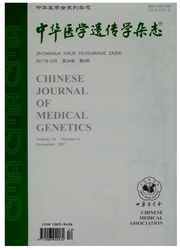

 中文摘要:
中文摘要:
目的在上海地区汉族人群中筛选Lu(a—b-)表型并统计该表型的频率。通过检测其LU基因及其相关EKLF/KLF1调控基因,揭示其分子机理。方法应用血清学方法对上海地区无偿献血者的Lub抗原进行筛选。对Lu(b-)个体鉴定其Lua、P1、i抗原。针对筛选出的Lu(a—b-)标本,对其LU基因的15个外显子以及相关的EKLF/KLF1基因3个外显子进行扩增并测序。结果在上海地区44331名无偿献血者标本中筛选出10份Lu(a—b-)标本。其LU基因均未发现纯合或杂合型突变,但在相关的EKLF/KLF1基因中发现7种不同的突变。结论Lu(a—b-)血型在上海地区汉族人群的频率约为0.02%,均为In(Lu)个体,其分子机制可能与EKLF/KLF1基因的杂合突变有关。
 英文摘要:
英文摘要:
Objective To study the frequency of rare blood group Lu (a- b--) phenotype in a population from Shanghai region, and to explore the molecular basis of Lu(a--b--) by detecting the Lu and Lu relative mediator gene EKLF/KLF1. Methods Donors from Shanghai region were screened for Lutheran blood group by monoclonal anti-Lub using serological methods. Individuals with Lu(b--) were determined Lua, P1 and i antigens. Fifteen exons of the LU gene and 3 exons of the EKLF/KLF1 gene for the identified Lu(a--b--) samples were amplified and sequenced. Results Ten Lu(a--b--) donors were obtained from 44 331 donors from Shanghai region. No homozygous or heterozygous mutations were found in the LU gene, whilst 7 mutations in EKLF/KLF1 gene were identified in the 10 samples. Conclusion The frequency of rare Lu(a--b--) blood group in Shanghai was approximately 0.02 %, and all the individuals had an In(Lu) phenotype. The molecular basis of such samples may be related to mutations in the EKLF/KLF1 gene.
 同期刊论文项目
同期刊论文项目
 同项目期刊论文
同项目期刊论文
 期刊信息
期刊信息
